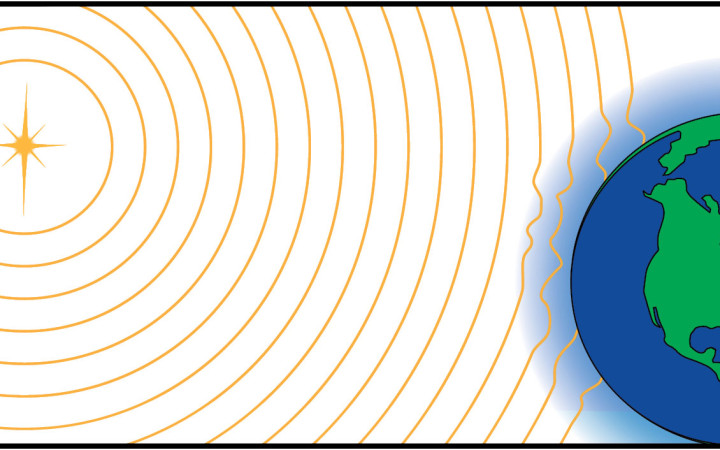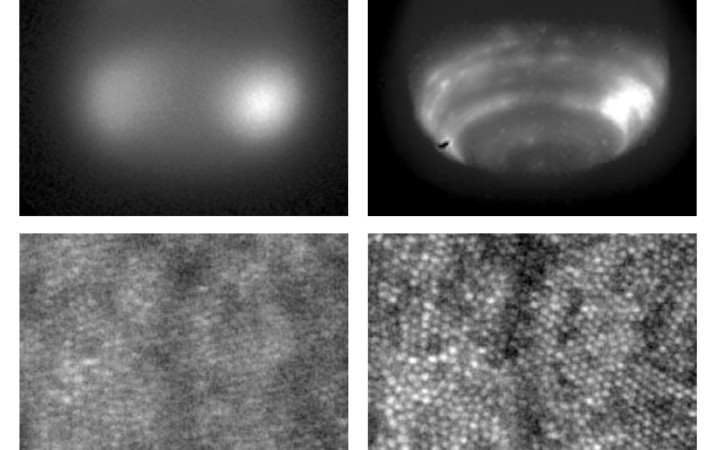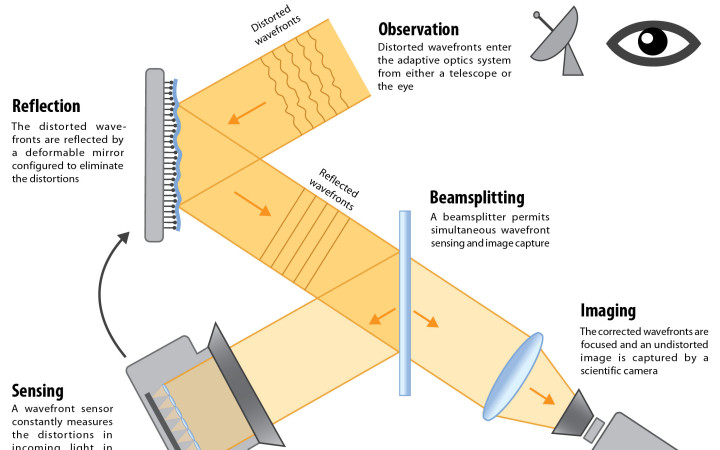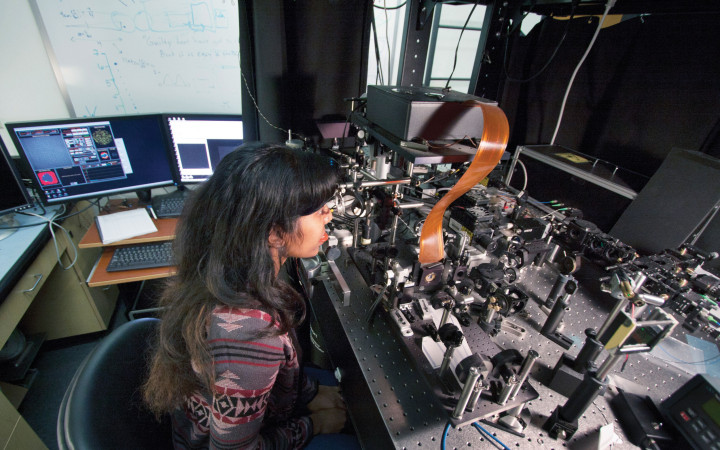
What do supermassive black holes millions of light years away and cells in the human eye have in common? Although these objects differ drastically in scale, scientific understanding of both has been vastly improved by a technology that also has important implications for the future of telecommunication: adaptive optics. Adaptive optics (AO) is a technique used to measure and correct distortions in light, enabling high-resolution images of objects that are typically difficult to resolve.
To appreciate how AO works, it is important to first conceptualize a wavefront of light and how a wavefront’s shape affects image quality. When light radiates from an object, rays leave the surface in every direction, much like your childhood drawings of the Sun. Since light actually travels in waves, not lines, imagine if you drew each light ray as a wave with the highest points (peaks) and lowest points (troughs) spaced equally apart. Now if you drew a circle connecting all of the peaks closest to the Sun, you would have a simple rendition of a wavefront—the shape made by connecting the points in each light wave with equal phase (e.g. peaks or troughs). Wavefronts close to the Sun are curved, while those much further away—such as at the surface of the Earth—are essentially flat. Perfect wavefronts from a distant source are always flat unless obstacles in their path scatter the individual light rays.
Twinkle twinkle, little star, adaptive optics reveals who you really are
Before the development of AO, telescopes on Earth could not achieve image quality comparable to that of telescopes in space due to light scatter caused by atmospheric turbulence. Due to the temperature gradient between the Earth’s surface and space, the atmosphere consists of many pockets of different densities and pressures that cause air to circulate—what we know as wind—and light to scatter. This scattering effect of the atmosphere is similar to how the bottom of a hot tub is more visible when the water is calm than when the jets are on; in the latter case, the motion of turbulent water scatters light reflecting off of the bottom of the tub before reaching your eyes, blurring the image you see. The atmosphere’s blurring effect, which makes objects in space difficult to image, can also be witnessed by the naked eye—it is the reason stars twinkle instead of appearing steady in the night sky.
 The light waves emitted by a distant star are represented as wavefronts (yellow lines). Upon entering the Earthís atmosphere, the wavefronts become distorted, blurring images of the star taken by a ground-based telescope. Adaptive optics corrects for these distortions, enabling the acquisition of high-resolution images in spite of atmospheric blur. (Credit: Keith Cheveralls)
The light waves emitted by a distant star are represented as wavefronts (yellow lines). Upon entering the Earthís atmosphere, the wavefronts become distorted, blurring images of the star taken by a ground-based telescope. Adaptive optics corrects for these distortions, enabling the acquisition of high-resolution images in spite of atmospheric blur. (Credit: Keith Cheveralls)
When light from the Sun passes through the Earth’s atmosphere, the individual rays scatter in different directions. These distortions change the incoming wavefront from a flat surface to an irregular one. The more light scatters, the less flat the wavefront becomes. AO measures the shapes of these irregular wavefronts using an optical instrument called a wavefront sensor, which measures where incoming light comes to a focus after passing through a set of lenses and how these positions differ from that of a perfect wavefront’s focus. Once the sensor determines the wavefront’s shape, the measurements are relayed to a computer that controls a deformable mirror, effectively a single large mirror composed of many smaller mirrors tiled together. Deformable mirrors mimic wavefront shapes like a pin-art novelty toy conforms to your hand, changing the positioning of individual small mirrors so that the overall mirror mimics the shape of an incoming wavefront.
When a distorted wavefront reflects off of a similarly shaped deformable mirror, the light striking each point on the mirror’s surface reflects in such a way that the resulting wavefront becomes flat. Since atmospheric wind patterns constantly change the shapes of incoming wavefronts, the deformable mirror and wavefront sensor must communicate hundreds, even thousands, of times per second to measure and correct errors in incoming light. By performing these corrections, telescopes using AO can approach diffraction-limited resolution, the fundamental limit on image sharpness due to the physical properties of light.
University of California scientists are heavily involved in the development and application of AO for astronomy. Dr. Claire Max, professor of astronomy and astrophysics at UC Santa Cruz, has contributed immensely to the development of AO systems and uses the technology to study planets and colliding galaxies. In 2000, working closely with UC Berkeley scientists at Lawrence Livermore National Laboratory, Max used AO to obtain the best Earth-based images of Neptune and Saturn’s moon Titan. Taken using the Keck II telescope in Hawaii, these images revealed giant Neptunian storms and possible frozen landmasses on Titan’s surface. Each pixel in these images reflected details on Neptune and Titan that were 0.06 arcseconds apart. To put the scale of this resolution into perspective, think of the size of the Moon when peering up at the night sky; two imaginary lines drawn from your eye to either side of the Moon would be separated by an angle of 0.5 degrees, or 1800 arcseconds. The Keck II telescope distinguished features on Neptune and Titan that were 0.06 arcseconds apart, or 1/30000 the diameter of the Moon’s disk, on objects millions of miles away!
 Images of Neptune (top) and cone photoreceptors in a living human retina (bottom) with and without the use of adaptive optics (left and right, respectively). The bright spots in the retinal image are individual cone cells, and the vertical line is the shadow of a blood vessel. The diameter of each cone is about five microns. (Neptune: Claire Max; retinas: Austin Roorda)
Images of Neptune (top) and cone photoreceptors in a living human retina (bottom) with and without the use of adaptive optics (left and right, respectively). The bright spots in the retinal image are individual cone cells, and the vertical line is the shadow of a blood vessel. The diameter of each cone is about five microns. (Neptune: Claire Max; retinas: Austin Roorda)
Rosalie McGurk, a PhD candidate working with Max, appreciates full well how AO has revolutionized the field of astronomy. “Adaptive optics has enabled stunning discoveries, such as proving the existence of the supermassive black hole in the Galactic Center of the Milky Way and imaging the first resolved planets in another solar system, that we wouldn’t have been able to image previously.” In her own research, McGurk searches for pairs of supermassive black holes inside colliding galaxies to better understand how they merge. Since black holes absorb light and must be observed indirectly, McGurk searches for evidence of glowing gas and dust falling into a black hole to determine its presence and location, a task made possible by AO.
AO has enabled a new generation of ground-based telescopes like the Thirty Meter Telescope, an ambitious international collaboration largely spearheaded by University of California scientists that will be the largest and most powerful ground-based telescope on Earth. The telescope, which is expected to be fully operational in 2022, will have a 30-meter primary mirror, slightly larger than a full-size basketball court, to enable unprecedented light capture from distant cosmic sources. Combined with a state-of-the-art AO system, the telescope will produce images 12 times sharper than the performance of the Hubble Space Telescope. Once the telescope is deployed, astronomers will be able see deeper into space than previously possible, essentially peering into the universe’s past via light that left its cosmic sources billions of years ago. By capturing light from such distant objects, scientists will be able to better study the formation of our universe, including the first stars born after the Big Bang and the formation of the first galaxies. Additionally, the telescope will provide more detailed images of extrasolar planets, distant galaxies, and supermassive black holes, creating a huge potential for scientific knowledge on how our universe came to be.
From the cosmos to the retina
The same technology helping us see objects millions of light-years away has also revolutionized how we peer into ourselves. The notion of measuring and correcting for distorted wavefronts in the human eye has been around since the 13th century in the form of eyeglasses. When light travels through your eye, imperfections in the transparent tissues called the cornea and lens prevent rays from coming to a perfect focus on the retina, the thin layer of cells at the back of the eye that senses light and mediates the first step in vision. Optometrists prescribe glasses to correct for defocus and astigmatism, two types of imperfections that can make daily tasks such as reading and driving difficult. Although correcting for these two aberrations is sufficient for daily life, there are many additional types of ocular imperfections that must be accounted for when acquiring high resolution images of the retina. Since the retina is highly reflective, a light beam shone into the eye will exit back out, and the outgoing wavefront can be measured and corrected using an AO system similar to that used in astronomy.
 (Credit: Keith Cheveralls)
(Credit: Keith Cheveralls)
The UC Berkeley lab of [Dr. Austin Roorda](http://Dr. Austin Roorda), professor of vision science and optometry, is a leader in AO-based vision research on the living human eye. Roorda developed the adaptive optics scanning laser ophthalmoscope (AOSLO), an instrument that scans the retina point by point to create a high resolution image of retinal cells without the need for surgery. The AOSLO can resolve fine detail in multiple retinal structures including photoreceptors, nerve fibers, and white blood cells in retinal capillaries, making it possible to study the diverse group of cells that affect the first crucial step in human vision.
Roorda’s laboratory studies how individual photoreceptors, the cells that collectively perceive the external world like pixels in a camera, contribute to visual perception. A bonus of AO is that the benefits of wavefront correction go two ways—not only can diffraction-limited images from the retina be captured, but diffraction-limited stimuli can be delivered to the retina to test the function of individual cells. The human retina has two types of photoreceptors, rods and cones. Rods are color-blind and mediate night vision, while cones perceive color, regulate daytime vision, and come in three different types—short- , medium-, and long-wavelength sensitive cells—that have different color sensitivities. These different cone types are interspersed throughout the retina, and each person has a unique pattern of cone distribution. The human eye can distinguish over 10 million colors due to the unique combinations of cone activations evoked by each color of light, similar to how nearly any paint color can be made by combining different amounts of the primary magenta, yellow, and cyan pigments. With the AOSLO, specific colors and intensities of light can be delivered to individual cones to identify their exact type. Once a person’s “cone map” is determined, further studies, such as how specific combinations of cones affect color perception, are possible.
Additionally, the ability to deliver diffraction-limited stimuli to individual cells enables acuity—a measure of the smallest details we can see—to be tested at the limits of human vision. During an eye exam, 20/20 acuity is considered normal due to the fact that the eye’s imperfect optics blur images beyond the level of detail we can actually perceive. In reality, humans could see up to twice as well as 20/20 if the eye were a perfect optical system, based on the density of cone photoreceptors in the retina. By correcting for the eye’s optical flaws, AO allows perceptual studies to be done at the visual limits imposed by the sampling density of photoreceptors rather than by the blurring effect of our imperfect eyes.
The single-cell resolution made possible by AO has been especially beneficial for studying the human fovea, the retinal region with the highest cone photoreceptor density, responsible for our sharp central vision. Scientific understanding of the human fovea has “benefited tremendously from adaptive optics. This is a part of the retina whose anatomical and physiological properties have proven difficult to study under a microscope as well as in animal models using electrophysiology,” Roorda explains. “Using AO, we’ve revealed individual differences in how cone photoreceptor cells are arranged at the fovea and we’re beginning to get insight in how signals from these cones are conveyed to other neurons in the retina and the brain.”
AO for studying retinal disease
Dr. Jacque Duncan, professor of clinical ophthalmology at UC San Francisco, collaborates with Roorda to study the eyes of patients with retinal degenerations, a diverse group of diseases that typically cause photoreceptor death and eventual blindness. Age-related macular degeneration is a leading cause of vision loss among people over the age of 50, and like other retinal degenerations, the age of onset and rate of progression varies from person to person, making it difficult to generalize how vision loss will occur. Using AOSLO to visualize individual cells in degenerating eyes, Duncan’s research team can track the patterns by which these diseases affect retinal structure, providing insight into the nature of disease progression and how it affects vision in individual patients.
 A vision researcher demonstrates the Roorda labís retinal imaging system. The optical components on the right direct a light beam into the subjectís eye. Adaptive optics measurements are performed by computers on the left. (Credit: Keith Cheveralls)
A vision researcher demonstrates the Roorda labís retinal imaging system. The optical components on the right direct a light beam into the subjectís eye. Adaptive optics measurements are performed by computers on the left. (Credit: Keith Cheveralls)
“AO imaging has provided valuable insights into the way different mutations affect photoreceptor structure, function, and survival,” Duncan notes. “Previously, all information about how genetic mutations cause photoreceptors to die was learned from histological studies of postmortem eyes—usually after extensive photoreceptor death had occurred—or from animal models, which differ in significant ways from human eyes. Thanks to adaptive optics, we can follow the progression of diseases in patients noninvasively, allowing us to learn much more about the effects of different diseases.”
AOSLO has also been used to study potential treatments for vision loss. In 2011, Duncan and Roorda studied the effects of ciliary neurotrophic factor, a protein shown to slow disease progression in patients with inherited retinal degenerations. The study tracked patients for over two years by routinely collecting AOSLO images of their treated and untreated retinas and comparing changes in photoreceptor density to changes in visual function, such as how far down an eye chart these patients could read. Interestingly, the AOSLO images indicated slower disease progression in the treated than untreated eyes, although there were no significant changes in how these patients performed during vision exams. These results suggested that AOSLO may provide more sensitive and objective measures of degeneration than conventional clinical tests of vision loss, an important factor to consider when monitoring disease progression in patients.
Imaging the living mouse brain
In addition to the eye, scientists have explored the use of AO for imaging other biological tissue, specifically the living brain of a mouse. Typically, imaging deep within the living brain is precluded by its lack of transparency; light rays from a single point in deep tissue scatter, making it difficult to localize their origin and bring them back into focus. A point light source in the tissue, akin to stars in astronomy, is necessary for measuring the light scatter from a specific region of tissue so it can be accurately corrected. As a surrogate point source, scientists inject fluorescent beads directly into brain tissue to act as “guide stars” for an AO system’s measurements. Once light scatter is corrected, fluorescent-labelled neurons from the same region can be imaged noninvasively, allowing scientists to visualize neural responses to specific stimuli and to study changes in neural structure and organization in response to learning or other behavioral factors.
Applications outside of academia
Although AO has made a significant impact on academic research, you may have also unknowingly benefited from this versatile technology. In recent years, AO has been integrated into LASIK, a procedure that eliminates the need for eyeglasses by using a laser to reshape the cornea. Although conventional LASIK successfully removes defocus and astigmatism, it increases the risk of creating other flaws in the cornea that are not measurable with traditional eye exams, though they can impair vision quality. Using a conventional AO system, laser eye surgeons can now obtain more accurate measurements of patients’ unique wavefronts, ensuring that the LASIK procedure is customized to their eyes’ imperfections and does not create additional flaws.
The military has independently pursued AO research for as long as the academic community has, and substantial defense funding has been redirected into developing laser weaponry. Currently in development is the High Energy Laser Mobile Demonstrator, a ground-based system designed to detect and destroy incoming rockets, artillery, mortars, and drones with a high-energy laser beam. Since target detection and laser energy can be severely hampered by atmospheric conditions, developers have integrated AO into the laser system to accurately localize incoming threats regardless of weather conditions and to recalibrate the weapon beam so it can deliver enough focused light energy to destroy a distant target. Due to the lower cost and ease of laser-based weaponry compared to traditional missiles, AO-enhanced lasers may become a key part of the military’s arsenal in the foreseeable future.
With the increasing usage of wireless devices worldwide, the demand for high-speed communications will soon exceed the bandwidth capabilities of current telecommunication infrastructure. Today, radio frequency communication has a low bandwidth and is susceptible to eavesdropping. While fiber optics technology is more secure and has a much larger and faster transmission rate, the huge installation costs make worldwide implementation unlikely. Free-space optical communication, an alternative technology in which data transfer occurs through the atmosphere or space via laser beams, will offer high security and bandwidth rates comparable to fiber optics without the need for physical cables to transmit signals. As in astronomy, atmospheric turbulence is a significant issue, but AO integration will make free-space data transfer a much more feasible option for telecommunication in a highly connected world.
Adaptive optics is a versatile technique that has enabled advancements in a wide range of fields, including astronomy, vision science, neuroscience, military defense, and telecommunication. University of California scientists have been pioneers in applying AO to astronomy and vision science, which has expanded our understanding of the origin of the universe as well as of fundamental properties of human vision. As the technology becomes more ubiquitous across different fields, communities of scientists, engineers, and other users have emerged to collaborate on the continual improvement of AO for the advancement of science, health care, and industry. As AO evolves, it will play a crucial role in advancing scientific knowledge of everything we measure with light, from celestial objects millions of light-years away to cells in your own eye.
This article is part of the Spring 2015 issue.



